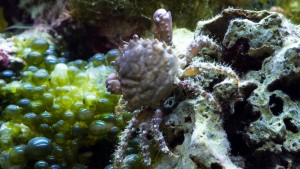Among the various and sundry marine life commonly sold to aquarium hobbyists for utilitarian purposes is the emerald crab (Mithraculus sculptus). Oft touted for its propensity to gobble up bubble algae and other irksome algal forms, M. sculptus has become a proud, card-carrying member of many a marine aquarium “cleanup crew.” But before adding this “benign” crustacean to your aquarium to control algae, be advised that it may not be as strictly herbivorous or reef-safe as you’ve been led to believe.
Physical traits
Aptly named for its shiny, emerald-green overall coloration, this Caribbean species reaches only a few inches in diameter and has a bumpy carapace, hairy legs, and relatively robust (for its size) claws. One could argue it even looks rather like the bubble algae it supposedly consumes with such enthusiasm.
About that bubble algae thing…
If you’re adding emerald crabs to your system in the hopes of eradicating a major outbreak of bubble algae or any other form of algae, you might be disappointed in the results. Not all specimens eat troublesome algae forms reliably, and even if they do, they may not eat enough of it to bring a severe outbreak under control.
Some years ago, I added a group to my 75-gallon reef tank when it was in the throes of a bubble algae plague, but they never really made much of a dent in the problem (it took a lot of handpicking and water changes to restore sanity).
About that herbivorous thing…
Also, as I alluded in my opening paragraph, M. sculptus isn’t strictly herbivorous. It’s an opportunistic omnivore that, in addition to grazing algae, will scavenge dead animals and may even attack and consume live ones—including coral polyps and small fishes. The scavenging behavior can be beneficial in aquariums, as it helps eliminate uneaten fish foods from little nooks and crannies in the rockwork, but the active hunting can obviously be problematic if the targeted prey happens to be one of your prized fish or invertebrates.
I can’t say how common attacks on fish actually are, but I can attest from personal experience that one of the emerald crabs that were (note the past tense) in my 75-gallon definitely made an attempt on my clownfish, actually shearing chunks out of the poor thing’s caudal and anal fins (the clown survived and still resides in that same tank today). Also, there are many anecdotal reports of rogue emerald crabs tearing apart and eating zoanthids and other soft corals in reef systems.
Suffice it to say, those claws aren’t just for decoration. So, if you choose to introduce one or more specimens of M. sculptus to a reef system, keep a close eye out for damage to livestock (which is most likely to occur after dark when these nocturnal crabs are active) and be prepared to remove the crabs if any is noted. If it turns out these crabs do have to be removed from a display tank, they can always be transferred to a refugium or sump where they can still be enjoyed but can’t do any damage to other animals.
Should you feed your emerald crab?
M. sculptus is not fussy and, as mentioned, will scavenge uneaten food, so virtually anything you offer your fish will be accepted by emerald crabs as well. Some authors suggest that keeping these crabs intentionally fed will help prevent them from turning on living invertebrates or small fish, but I would keep a watchful eye on them in this regard nonetheless.
Housing
Since they reach only a few inches in diameter, emerald crabs can be kept in virtually any sized system, provided there is plenty of live rock aquascaping for them to forage on. Just be mindful of their potential to snare small fish—or to be eaten by larger ones—and that they may not be entirely trustworthy around soft corals.



